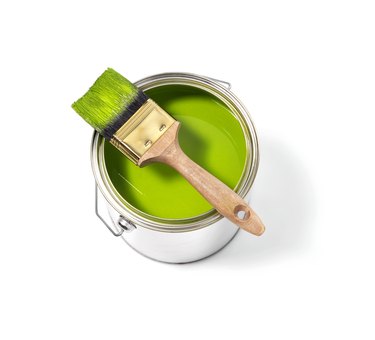Gloss, semi-gloss and flat paint differ in pigment concentration, which is one of the three key paint ingredients. In addition, flat paint may contain additives to cut the sheen. Neither of these differences prevents you from mixing paints with different sheens, as long as they have the same solvent and binders. The result of mixing semi-gloss and flat paint depends on the relative concentration of each, but it will be somewhere in between semi-gloss and flat, which is normally designated "satin."

Video of the Day
Pigment Volume Concentration
The three main ingredients in paint are the pigment, the binder and the solvent. The binder in modern paints is usually a synthetic resin, such as acrylic or polyurethane. It's what makes the paint glossy. The pigment gives paint its color, but pigments scatter and absorb light instead of reflecting it, so they tend to dull the sheen. The pigment volume concentration (PVC), which is the ratio of pigment volume to the total volume of pigment and binder, is the quantity paint manufacturers use to measure the amount of pigment. Paints with low PVC tend to be glossy, while those with high PVC are flat. When you mix a flat paint with a gloss or semi-gloss one, you alter the PVC, and the sheen depends on the final ratio of flat to semi-gloss.
Video of the Day
Same Solvent, Same Binders
You should mix paints only if they have the same solvent. This is a commonsense requirement that you probably already know. Water-based paint won't mix with an oil-based one, and here, "oil-based" means any paint that isn't water-based. Some binders are compatible with each other, but to be on the safe side, it's best to mix paints only if they contain the same resins. This means you shouldn't mix an acrylic latex paint with a water-based polyurethane one.
Test the Mixture Before Using It
There's no hard-and-fast rule for obtaining a specific sheen by mixing semi-gloss and flat paint. As a rule of thumb, the higher the pigment concentration, the flatter the paint, so the more flat paint you add to the mixture, the duller the final sheen will be. This is true even if the flat paint contains light-dispersing additives because the more flat paint you add to the mixture, the higher will be the concentration of these additives.
The only way to tell if the paint has the required sheen for your project is to spread it on a test surface and let it dry. If you plan to use the paint on your walls, test it on a scrap piece of primed drywall to get the most accurate idea.
Mix Large Batches
It's sometimes difficult to get the same results when mixing two separate batches of paint. The color and sheen often vary slightly, and you might not notice the difference until after the paint dries. Avoid do-overs by mixing all the paint you need for your project at the same time.